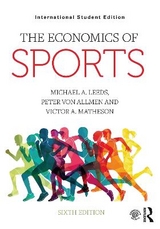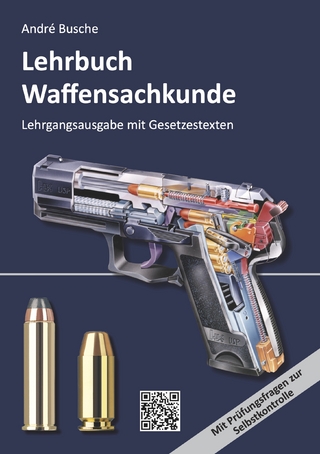
The Economics of Sports, Global Edition
Routledge (Verlag)
978-1-292-08178-6 (ISBN)
- Titel erscheint in neuer Auflage
- Artikel merken
Core economic concepts developed through examples from the sports industry.
The sports industry provides a seemingly endless set of examples from every area of microeconomics, giving students the opportunity to study economics in a context that holds their interest. The Economics of Sports explores economic concepts and theory—industrial organization, public finance, and labor economics—in the context of applications and examples from American and international sports.
Michael Leeds is Professor of Economics at Temple University, USA Peter von Allmen is Professor and Chair at the Economics Department at Skidmore College, USA
1. Economics and Sports
Introduction
1.1The Organization of the Text
1.2 Babe Ruth and Comparative Advantage
Summary
Discussion Questions
Problems
2. Review of the Economist’s Arsenal
Introduction
2.1 The Supply and Demand Model
2.2 Producing Output and the Production Function.
2.3 Market Structures: From Perfect Competition to Monopoly
2.4 The Rise of Professional Sports
Summary
Discussion Questions
Problems
APPENDIX 2A
2A.1 Constrained Maximization
2A.2 Using Indifference Curves and Budget Constraints: The Rise of Soccer and Baseball
APPENDIX 2B
3. Sports Franchises as Profit-Maximizing Firms
Introduction
3.1 Maximizing Profits or Maximizing Wins?
3.2 A Closer Look at Revenues, and Costs
3.3 Taxes, Profit, and Owner Behavior
3.4 The Importance of Leagues
3.5 Soccer’s Alternative Business Model
Summary
Discussion Questions
Problems
4. Monopoly and Antitrust
Introduction
4.1 What’s Wrong with Monopoly?
4.2 Strategic Pricing and Price Discrimination
4.3 What’s Right with Monopoly?
4.5 Society’s Response to Monopoly and Monopsony: Antitrust Laws
4.6 The NCAA: An Incidental Cartel
4.7 Prisoner’s Dilemma: How Rational Actions Lead to Irrational Outcomes
Summary
Discussion Questions
Problems
APPENDIX 4A
5. Competitive Balance
Introduction
5.1 Why Fans and Owners Want Competitive Balance
5.2 Measuring Competitive Balance
5.3 Attempts to Alter Competitive Balance
Summary
Discussion Questions
Problems
6. The Public Finance of Sports: Who Benefits and How?
Introduction
6.1 How How Teams Benefit from New Facilities
6.2 How Fans Benefit from a New Facility
6.3 How Cities Benefit from Teams, Facilities, and Events
Summary
Discussion Questions
Problems
7. The Public Finance of Sports: Who Pays and Why?
Introduction
7.1 How Cities Came to Fund Stadiums
7.2 How Teams Exploit Monopoly Power
7.3 Stadium Location and Costs
7.4 Stadium Costs and Financing
7.5 Paying for Stadiums
Summary
Discussion Questions
Problems
8. An Introduction to Labor Markets in Professional Sports
Introduction
8.1 An Overview of Labor Supply and Labor Demand
8.2 The Economics of Tournaments and Superstars
8.3 Tournaments, Cheating, and the Distribution of Income
Summary
Discussion Questions
Problems
APPENDIX 8A
9. Labor Market Imperfections
Introduction
9.1 The Monopsony Power of Sports Leagues
9.2 Unions in Professional Sports
9.3 Labor Conflict and Compromise in Collective Bargaining
Summary
Discussion Questions
Problems
10. Discrimination
Introduction
10.1 Becker’s Theory of Labor Discrimination
10.2 Different Forms of Discrimination in Professional Sports
10.3 Title IX and Discrimination in College Sports
Summary
Discussion Questions
Problems
11. The Economics of Amateurism and College Sports
Introduction
11.1 The Troublesome Concept of Amateurism
11.2 The Costs and Benefits of College Athletics
11.3 The Role of the NCAA
11.4 The Returns to the Athlete
Summary
Discussion Questions
Problems
| Erscheint lt. Verlag | 13.11.2014 |
|---|---|
| Verlagsort | London |
| Sprache | englisch |
| Maße | 231 x 190 mm |
| Gewicht | 752 g |
| Themenwelt | Sachbuch/Ratgeber ► Sport |
| Wirtschaft ► Volkswirtschaftslehre | |
| ISBN-10 | 1-292-08178-3 / 1292081783 |
| ISBN-13 | 978-1-292-08178-6 / 9781292081786 |
| Zustand | Neuware |
| Informationen gemäß Produktsicherheitsverordnung (GPSR) | |
| Haben Sie eine Frage zum Produkt? |
aus dem Bereich



